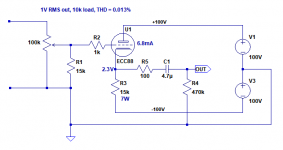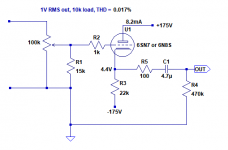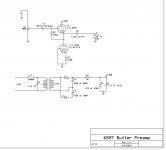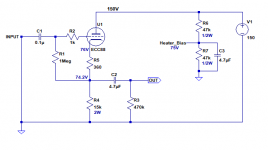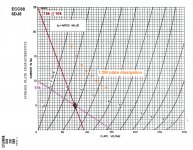I think you have the EZ pointing the wrong way. 
Low Z output with cathode followers are overkill most of the time. An RC loaded 12AX7 is one thing, a 300R cathode follower another.
Is adding an extra cap at the input, using a cathode follower and a huge output cap really worth it vs lowering gain in the DAC or poweramp? None of those three really improve the sound quality.
Low Z output with cathode followers are overkill most of the time. An RC loaded 12AX7 is one thing, a 300R cathode follower another.
Is adding an extra cap at the input, using a cathode follower and a huge output cap really worth it vs lowering gain in the DAC or poweramp? None of those three really improve the sound quality.
If the input cap on the cathode follower bugs you, it's easy enough to bias a CF with its grid at 0V (ground) if you use a bi-polar power supply. Say you took a 6DJ8 (ECC88) and used a +/-100V power supply. No input cap needed. Output cap still necessary.
If you'll only be feeding the buffer from a DAC or digital player, the input impedance can be down around 13k ohms with no worries. Try Rod Elliott's trick of making an approximately log-taper 13k stereo volume control by taking a 100k linear-taper ganged pot and putting a 15k ohm resistor from each wiper to ground.
The predicted THD is something like 0.013% into a 10k load, and all second harmonic. THD would be lower into lighter loads. Nothing audible.
With low voltages like that, you could make the power supplies all regulated. Or filter the heck out of them with 1000uF 160V capacitors. Like these.
I should make one of these with a 3-position input selector switch and some decent RCA jacks. It would be a useful thing to have around.
--
If you'll only be feeding the buffer from a DAC or digital player, the input impedance can be down around 13k ohms with no worries. Try Rod Elliott's trick of making an approximately log-taper 13k stereo volume control by taking a 100k linear-taper ganged pot and putting a 15k ohm resistor from each wiper to ground.
The predicted THD is something like 0.013% into a 10k load, and all second harmonic. THD would be lower into lighter loads. Nothing audible.
With low voltages like that, you could make the power supplies all regulated. Or filter the heck out of them with 1000uF 160V capacitors. Like these.
I should make one of these with a 3-position input selector switch and some decent RCA jacks. It would be a useful thing to have around.
--
Attachments
Just out of curiosity, are there any octal tubes that similar to the ECC88? I only ask because a single 9-pin tube on top of a chassis looks a little sad. I know, it's a terrible reason, but usage of an octal tube makes the chassis design (cosmetics) easier. Of course, I could use octal tubes for the CCS or power supply.
Not that i'm aware of. But you can always use 6cw4 , they look pretty !
http://n.manet.nu/tubedoc/6CW4-2.pdf
http://n.manet.nu/tubedoc/6CW4-2.pdf
A 6SN7 makes a perfectly good cathode follower.
The Russian 6N8S is a perfectly fine and reasonably priced 6SN7.
Or if one 6DJ8 on a chassis looks 'lonely' you can always parallel its twin sections, making it an even better cathode follower, and have two 6DJ8s on your chassis.
Or add a tube series regulated power supply with a tube rectifier. Then you can have a whole forest of tubes on your chassis. Something like this maybe? (Not checked to see if it's any good, just shown as an example. Also, it's not a +/- power supply; it's positive voltage only.)

6V6 can become 6AQ5
6X5GT can become 6X4
Then all the tubes can be 7 or 9 pin minis.
--
The Russian 6N8S is a perfectly fine and reasonably priced 6SN7.
Or if one 6DJ8 on a chassis looks 'lonely' you can always parallel its twin sections, making it an even better cathode follower, and have two 6DJ8s on your chassis.
Or add a tube series regulated power supply with a tube rectifier. Then you can have a whole forest of tubes on your chassis. Something like this maybe? (Not checked to see if it's any good, just shown as an example. Also, it's not a +/- power supply; it's positive voltage only.)

6V6 can become 6AQ5
6X5GT can become 6X4
Then all the tubes can be 7 or 9 pin minis.
--
Attachments
Last edited:
Here's where I'm at right now. I did have to abandon the idea of using the 120V to 120V isolation transformer. You could ABSOLUTELY substitute one. The distortion would rise a slight bit, however it is not likely to be noticeable. WIth 400V on the plate, the distortion is in theory around .005%, but in practice will be higher. Gain is slightly less than one. Attached is the schematic, as well as an LTspice file with the necessary models file.
Attachments
Can you say if this can use the Russian 6N2P EV and what mods would be required?Here's my contribution to the simple tube buffer pile (12AU7):
Muchedumbre Buffer Preamp – wauwatosa tube factory
No fancy parts or tricks; just a cathode follower. Buffers make good preamps in my experience. Like you, I've found that most tubes have too much gain as grounded cathode amplifiers.
Without looking up the data sheet from memory i think it’s 6.3v wired to pins 4 & 5 and an Earth on pin 9.
Thanks
The 6N2P might work, but it's not a good choice for a cathode follower. It is similar to a 12AX7- a high-mu triode. Typically the best tubes for an application like this are low-mu triodes like the 6SN7, 12AU7, ECC88, 12BH7, etc. The 6N1P would be a much better choice, as it is quite similar to an ECC88. Lots of people like how they sound, though this preamp will add very little color to the sound.
My plan is to modify my existing 12AU7 preamp to this design, using the second triode as a CCS. The 12AU7 is a good choice for this application, as with 100% feedback its less-than-linear plate curves become a non-issue.
My plan is to modify my existing 12AU7 preamp to this design, using the second triode as a CCS. The 12AU7 is a good choice for this application, as with 100% feedback its less-than-linear plate curves become a non-issue.
I concur. A higher transconductance tube is the better choice than 6N2P here. 6N1P, 6N3P, 6N27P, etc. Only change for these may be the loading resistor and pinout.
Thanks,
How do you work out the value of the loading resistor for the 6np1 (near to 12au7) or 6np3 near to (ECC88) I think?
I think they require higher mv according to the data sheets.
Could you say what you would change to and if it’s possible to fit a switch to choose between the two?
Thanks again
Sorry to revive an old thread, but I really enjoyed your website and different tutorials about making the chassis and wiring this thing. So thanks a lot, it is now on the todo list 
Quick question though, you never mention (or I missed it) where you got the aluminum plate from. Cutting holes is one thing, but I'm having a hard time sourcing aluminum sheets cut to a decent size (for a reasonable price). Is it from anywhere online?
Thanks,
Quick question though, you never mention (or I missed it) where you got the aluminum plate from. Cutting holes is one thing, but I'm having a hard time sourcing aluminum sheets cut to a decent size (for a reasonable price). Is it from anywhere online?
Thanks,
Hi and thank you! I am glad you find the site useful.
I buy my Alu plate at Speedy Metals. No affiliation but they have a local location where I can pick up. They'll cut to size and price is very reasonable. I'm sure they ship, but no idea what postage to Canada would look like.
I buy my Alu plate at Speedy Metals. No affiliation but they have a local location where I can pick up. They'll cut to size and price is very reasonable. I'm sure they ship, but no idea what postage to Canada would look like.
Metal supermarkets isn't cheap but they might be reasonable enough?
https://ecommerce.metalsupermarkets.com/MSC-Home.aspx
https://ecommerce.metalsupermarkets.com/MSC-Home.aspx
Hi and thank you! I am glad you find the site useful.
I buy my Alu plate at Speedy Metals. No affiliation but they have a local location where I can pick up. They'll cut to size and price is very reasonable. I'm sure they ship, but no idea what postage to Canada would look like.
+1 for Speedy Metals. One of a a relatively small number of companies that will sell you small quantities of stock.
Here's my contribution to the simple tube buffer pile (12AU7):
Muchedumbre Buffer Preamp – wauwatosa tube factory
No fancy parts or tricks; just a cathode follower. Buffers make good preamps in my experience. Like you, I've found that most tubes have too much gain as grounded cathode amplifiers.
I would like to build this. I have a ECC82, and a 220 to 110 volt trato. I get a rectified voltage of 160 volts. I am not comfortable with higher voltages than this. ( newbie for tubes. No experience with voltage doublers for higher voltages. I can't read load lines and i am still learning it. It would be very useful if you can give me suitable resistor. Values for a B+ of 160 volt. I also don't understand by heater tap elevation ground,But i generally use a seperate Regulated DC supply for filament..
Thanks in advance
I would like to build this. I have a ECC82, and a 220 to 110 volt trato. I get a rectified voltage of 160 volts. I am not comfortable with higher voltages than this. ( newbie for tubes. No experience with voltage doublers for higher voltages. I can't read load lines and i am still learning it. It would be very useful if you can give me suitable resistor. Values for a B+ of 160 volt. I also don't understand by heater tap elevation ground,But i generally use a seperate Regulated DC supply for filament..
Thanks in advance
The heater tap elevation is to avoid exceeding the maximum heater-to-cathode voltage difference specified in the tube datasheet. The filament winding is isolated from the B+ winding. The filament winding is then "floated" so it that it has a DC potential of 100V (or whatever), but there is still a 12.6V AC potential across the tube filament.
There are ways of using a regulated DC filament supply, however, you will still need to consider the maximum heater-to-cathode voltage. As a hint, DC filaments are not always as simple to implement as they seem.
For a voltage that low (150V Ebb) I would say an ECC82 won't work very well. That tube requires a bit higher voltage to work well as a buffer.
What would you think of using ECC88 instead? That's a common enough tube, and will work well with a 150V Ebb if you use a 15k cathode load resistor, 360 ohm cathode bias resistor.
Since ECC88 has a maximum heater-to-cathode voltage of only 50V, you'll need to reference the heater supply 'ground' to +75V or thereabouts. That's easy though. Just make a voltage divider of two 47k ohm resistors
Make the output capacitor a larger value, like 4.7uF, if you're going to use it into a contemporary amplifier like one of those little class D things. 1uF is fine if you're going to use it into a tube amp.
Something like this, maybe?
What would you think of using ECC88 instead? That's a common enough tube, and will work well with a 150V Ebb if you use a 15k cathode load resistor, 360 ohm cathode bias resistor.
Since ECC88 has a maximum heater-to-cathode voltage of only 50V, you'll need to reference the heater supply 'ground' to +75V or thereabouts. That's easy though. Just make a voltage divider of two 47k ohm resistors
Make the output capacitor a larger value, like 4.7uF, if you're going to use it into a contemporary amplifier like one of those little class D things. 1uF is fine if you're going to use it into a tube amp.
Something like this, maybe?
Attachments
- Home
- Amplifiers
- Tubes / Valves
- Tube Buffer Preamp Design
